1)Pátzcuaro: Mexico's Enchanting Lakeside Village 墨西哥帕慈库罗:迷人的湖边村落
The petite, 2)raven-haired women in their shimmery, rainbow-colored 3)pleated skirts jumped off the boat, carrying bundles and bags, and then disappeared up the stairs that climbed the steep hillside wherever I looked.
这是一群身材娇小,头发黑亮,身穿闪着微光的七彩褶裙的妇女。她们手提着大包小包的东西,跳下小船,转瞬间就消失在那些通往陡坡的台阶上。在这里,我目光所及之处都是这种陡坡。
I scurried to follow. I was intrigued by these living symbols of folk tradition, who still wore the finely 4)embroidered blouses and silken skirts of their ancestors, as they went about their daily routines. But the Indian women seemed to evaporate like a fading rainbow into a 5)rabbit warren of stairstep shops, rooftop terraces, and 6)crooked alleyways.
我匆忙跟了上去。这群妇女如今仍像她们的先辈一样,在日常生活中穿着有精美绣花的上衣和丝裙,她们这些当地民间传统的活生生的象征激起了我的好奇心。可这群印第安妇女如同消失的彩虹一般,在一个拥挤不堪且杂乱的居民区里不见了踪影。这个居民区里到处都是设在阶梯两旁的店铺、屋顶露台和弯弯曲曲的小巷。
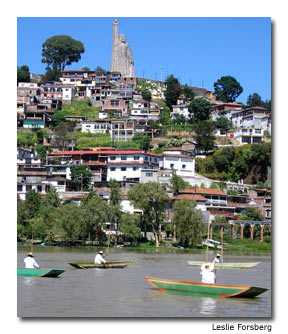 My husband, Eric, and I were visiting 7)Janitzio—a tiny, 8)gumdrop-shaped island on 15-mile-long Lake Pátzcuaro, 9)tucked among volcanic mountains in Mexico’s 10)Michoacán state. The houses, churches and other buildings on the island seemed squeezed, as if by a giant grip, pressing skyward. We had approached Janitzio on a long, wooden, 11)canopied boat filled with three dozen passengers, mostly Indians returning from their marketing chores in the lakeside town of Pátzcuaro, and a few Mexican tourists.
My husband, Eric, and I were visiting 7)Janitzio—a tiny, 8)gumdrop-shaped island on 15-mile-long Lake Pátzcuaro, 9)tucked among volcanic mountains in Mexico’s 10)Michoacán state. The houses, churches and other buildings on the island seemed squeezed, as if by a giant grip, pressing skyward. We had approached Janitzio on a long, wooden, 11)canopied boat filled with three dozen passengers, mostly Indians returning from their marketing chores in the lakeside town of Pátzcuaro, and a few Mexican tourists.
我和丈夫艾力克来到贾尼兹奥岛游玩。这个极小的、形状像橡皮软糖的小岛坐落在15英里长的帕慈库罗湖中,隐藏在墨西哥米却肯州的火山群里。岛上的房子、教堂和其他建筑物就像是被一只巨掌握紧一样,都使劲儿地往上伸。我们是乘坐长长的有顶篷的木船到贾尼兹奥岛的。30多名同船的乘客,大部分是从湖边小镇帕慈库罗的集市归来的印第安人,另外还有几位墨西哥游客。
We 12)disembarked in a plaza, and worked our way up the well-worn stone steps. We crept upward 150 feet until we emerged from the 13)stuffy, tomblike interior, to an observation platform teased by a fresh breeze.
我们在一个广场边上了岸,然后踏着被无数人踏过的石阶往上走。我们在一个像坟墓一样不透气的建筑内部爬了150英尺(约46米),终于来到一个微风吹拂的观景台。
The lake spread before us to nearby islands, distant green hills that looked like 14)rumpled velvet, and farm fields. To the south, we could make out the patch of buildings on the forested slope that is Pátzcuaro—one of the loveliest towns in Mexico, and the place where we were staying. This high mountain town of 45,000, surrounded by pine forests and lush tropical 15)vegetation, is in an area where the volcanic soil and moist heat of the day create a jungle-like profusion. The town’s two plazas are shaded by immense elm trees that form a 16)canopy over the 17)adobe buildings with red tile roofs. Red-and-black signs, all using the same style of writing, identify each business.
展现在我们面前的是宽阔的湖面,还有附近的小岛和农田,远处的青山看上去就像是弄皱的天鹅绒。在南面,我们可以看到被森林覆盖的山坡上的建筑群,那就是帕慈库罗,墨西哥最可爱的小镇之一,我们就留宿在那里。这个高山小镇有45000个居民,周围是松树林和茂盛的热带植物。在那里,火山灰和白天潮湿的热气使丛林类植物非常繁茂。镇上两个集市被高大的榆树遮蔽,榆树荫在红瓦顶的土坯房上形成了一个华盖。房子上用相同字体写成红黑两色的标志以区分每一家的商铺。
We had arrived in Pátzcuaro in the evening, and settled into La Mansión de los Sueños, (House of Dreams), a lovely boutique hotel in a restored 17th century home, with hand-carved furniture, folk art and a fireplace in each room.
我们在晚上到达帕慈库罗,住进了“梦之居”客栈。这个精致的小客栈是一所经过修复的17世纪的房子,每间客房里都有手工雕刻的家具、民间工艺品和壁炉。
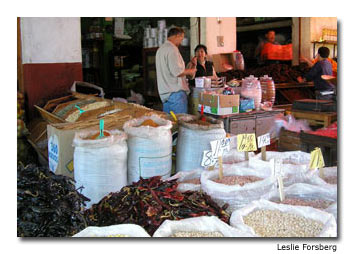 Next morning, we set off to explore the area. Following a small group of people on the road, we turned a corner and wandered into the town’s market. We waded into the bustling crowd, some shopping, and some selling their local harvest or catch at rustic wooden stalls or just out of baskets lined up in the church square. A 18)hum of conversation swirled around us as 19)diminutive grandmas in 20)gingham aprons and shawls, their hair wrapped in cloth, pushed past, carrying bundles and crates.
Next morning, we set off to explore the area. Following a small group of people on the road, we turned a corner and wandered into the town’s market. We waded into the bustling crowd, some shopping, and some selling their local harvest or catch at rustic wooden stalls or just out of baskets lined up in the church square. A 18)hum of conversation swirled around us as 19)diminutive grandmas in 20)gingham aprons and shawls, their hair wrapped in cloth, pushed past, carrying bundles and crates.
第二天上午,我们到附近闲逛。我们在路上跟着一小群人,拐过街角,走进了镇上的集市。我们费劲地挤进了熙熙攘攘的人群中。他们有些人在采购,有些人在简陋的木头搭建的货棚里卖当地的农产品或者猎物,还有人在教堂前的广场上把装着货物的篮子排成一行。我们的周围是嗡嗡的说话声,身材小巧的老奶奶们系着方格围裙,围着披肩,头发裹在布里,手上拎着包和筐,挤着走了过去。
21)Papayas, oranges and lemons were stacked high in the fruit section. Near the church door, used clothing was heaped in piles on the 22)cobblestones. Back toward the street, permanent market stalls catered to those in need of embroidered blouses, a shave or hardware. Three little girls in pink and orange dresses played ring-around-the-rosy in the center of the sidewalk. They flashed shy, curious smiles, as we edged past.
在卖水果的地方,木瓜、橙子和柠檬堆得高高的。在教堂门口旁边,鹅卵石道上堆着一堆堆的旧衣服。回到街上,固定的摊档卖的是人们需要的有绣花的上衣、剃须刀和日用五金。在人行道中央,3个身穿粉色和橙色裙子的小女孩在玩围着玫瑰丛绕圈子的游戏。我们侧身经过时,她们脸上露出羞怯而好奇的微笑。
Leaving the market behind, we strolled to Plaza Vasco de Quiroga, to shop for some of the local crafts. When Spanish 23)bishop 24)Don Vasco de Quiroga was sent to Pátzcuaro in 1536, he decided to help improve the local economy. He did this by encouraging the people living in traditional villages around Lake Pátzcuaro to develop unique crafts, which they could use for trading. This early business venture blossomed, and today the region is well known for its traditional crafts: hand-painted pottery, copper plates, woven tablecloths, silver jewelry, and straw 25)ornaments.
离开集市,我们漫步到基罗加广场,打算买些当地的工艺品。1536年,西班牙主教基罗加阁下被派到帕慈库罗,他决定要帮助改善当地的经济状况。他的做法是鼓励住在帕慈库罗湖周边传统村落里的人发展自己独特的手工艺品,用于交易。这笔早期的生意迅速壮大,如今这个地方以传统工艺品闻名,包括手绘陶器、铜盘、纺织的桌布、银首饰和草编的饰品。
In El Mesón Galeria, gorgeous pottery pumpkins in green, gold and brown 26)hues with 27)whimsically curly vines caught my interest. They were displayed next to heavy glassware with 28)cobalt blue 29)rims, and wooden religious icons. Painted tin decorations—hearts, crosses and other symbols—made up a 30)kaleidoscope-bright display on one wall.
在厄尔美森画廊,一些南瓜形陶器吸引了我的目光,这些绿色、金色、褐色的陶器上有一些卷曲得很古怪的藤蔓。陶器旁边陈列着边缘为深蓝色的大件玻璃器皿和一些木制宗教圣像。心形、十字架形和其他符号的彩绘锡制饰物,把一堵墙装饰得如万花筒般鲜艳。
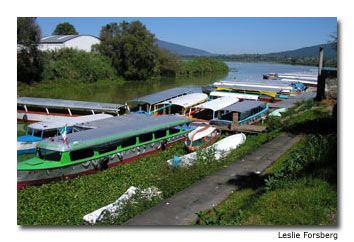 When we had our fill of shopping, we settled onto a bench in the square nearby. An evening concert in the courtyard of a local college brought out a blend of locals from 31)well-coifed women in pantsuits, to moms in shawls and 32)voluminous skirts, with toddlers on their laps. As day settled into evening, bats flew overhead, and Grupo Gaban, five musicians in 33)serapes played festive music from throughout Mexico on violins, guitars, a 34)clarinet, and a harp.
When we had our fill of shopping, we settled onto a bench in the square nearby. An evening concert in the courtyard of a local college brought out a blend of locals from 31)well-coifed women in pantsuits, to moms in shawls and 32)voluminous skirts, with toddlers on their laps. As day settled into evening, bats flew overhead, and Grupo Gaban, five musicians in 33)serapes played festive music from throughout Mexico on violins, guitars, a 34)clarinet, and a harp.
购物后,我们在附近广场上的一张长凳上坐了下来。当地一间学院的庭院里正在举行一场夜晚音乐会。听众中汇集了各色各样的当地人,有穿戴整齐的妇女,有围着披肩,穿着宽大的裙子,膝上坐着刚学走路的孩子的母亲。夜幕渐渐降临了,蝙蝠在头上掠过。格鲁波·加班乐队的5位身披瑟拉佩的音乐家用小提琴、吉它、单簧管和竖琴演奏着墨西哥各地的喜庆音乐。
Two bright-eyed little girls in 35)braids and 36)ruffled party dresses played hide-and-seek, families relaxed and chatted after a day’s work, and Eric and I sat among them, 37)ruminating about the vividness of life here, and feeling very much a part of this inviting, beautiful place.
两个小女孩扎着辫子,身穿褶边宴会服,眨着两只明亮的眼睛,在玩捉迷藏。工作一天后,家家都在歇息、聊天。我和艾力克坐在他们当中,想着这里多姿多彩的生活,觉得自己也是这个美丽动人的地方的一部分。
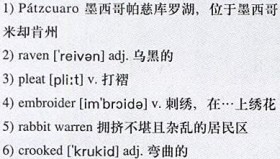
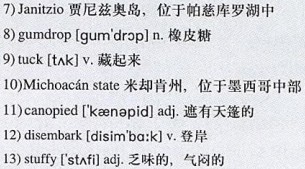
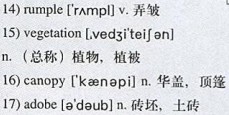
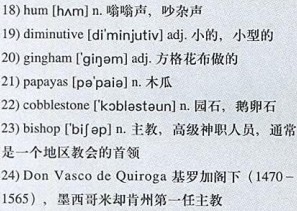
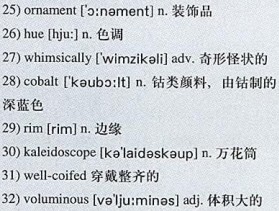
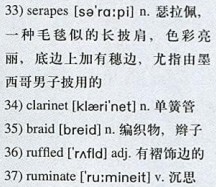
小资料:墨西哥的“亡灵节”
每年从10月30日起,墨西哥举国欢度“亡灵节”(也叫“死人节”)。墨西哥的这一节日,既与西方的“万圣节”有相似之处,又不完全相同,表现了浓厚的印第安民族文化特色。人们通过守灵、上贡等方式祭奠逝去的亲人。
亡灵节期间,人们在墓地通往村庄或者小镇的路上撒了黄色的花瓣,让亡灵循着芬芳的小路归来。晚间,在家门口点上南瓜灯笼,为亡灵上门引路;在祭坛上摆着玉米羹、巧克力、面包、粽子、辣酱、南瓜、甜食、甜点等供品,让亡灵享用。节日里,无分男女老幼,都可以戴着面具,穿上印着白骨的鬼怪衣服,在街上招摇过市,表示亡灵归来。人们还在公墓里弹奏音乐,并且写一些‘骷髅’诗互相取笑。报纸上也在“亡灵节”这一天,用整版的篇幅刊登总统、内阁部长与知名人士的骷髅漫画,配上墓志铭。被画成骷髅的人也引以为荣幸,表现出墨西哥民族乐观豁达的性格和对待死亡的幽默态度。
死人节虽然是全国性节日,在米却肯州(Michoacán state)的贾尼兹奥岛(Janitzio)过节气氛和习俗最浓厚。
